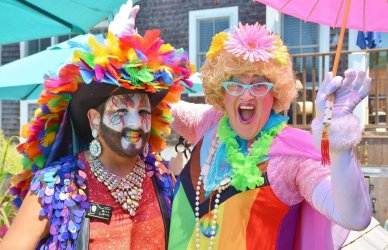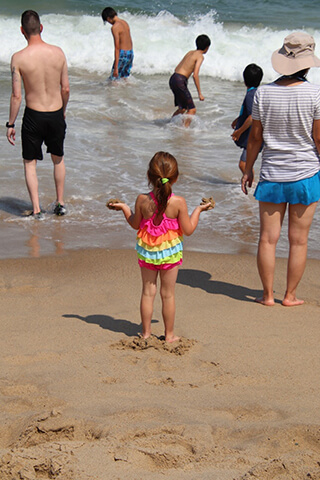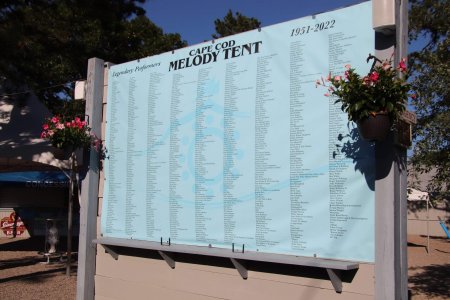Just like the human residents of Cape Cod, some of the regions’ birds call the area home year-round, while others are migratory birds of Cape Cod.
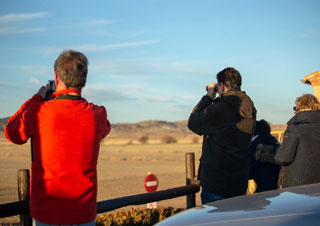 The fall is a great time to observe the migratory birds of Cape Cod making their way south and those birds that stay in the area getting ready for winter. The bulk of Cape Cod’s migratory bird species fly south between August and October. With the fall, Cape Cod bird migration is a bit more spread out than the concentrated rush to mating and nesting grounds in the Spring.
The fall is a great time to observe the migratory birds of Cape Cod making their way south and those birds that stay in the area getting ready for winter. The bulk of Cape Cod’s migratory bird species fly south between August and October. With the fall, Cape Cod bird migration is a bit more spread out than the concentrated rush to mating and nesting grounds in the Spring.
In addition to the coastal shorebirds that migrate from the Cape, avid birders can also spot species using the Atlantic Flyway, a sort of highway for migrating birds who travel from their Arctic breeding grounds to winter in Central and South America.
In the Cape’s tidal flats, you can spot migrating coastal waterbirds including plovers, sandpipers, dowitchers, dunlin, oystercatchers, sanderlings, red knots, yellowlegs, whimbrels, ruddy turnstones, and godwits. They eat as much as they can, trying to store the fat that enables them to travel long distances. In addition to the shorebirds, songbirds, hawks, ospreys, snowy owls, and other rare species can be spotted migrating.
Great spots to bird watch include Mass Audubon’s Wellfleet Bay Wildlife Sanctuary, Sandy Neck in Barnstable, Morris Island in Chatham, West Dennis Beach, South Cape Beach in Mashpee, Nauset Marsh in Eastham, Fort Hill in Eastham, Seagull Beach in Yarmouth, Race Point in Provincetown, Cowyard Lane in Chatham, Monomoy Island in Chatham, and countless other beaches, marshes, conservation areas, ponds, and more!
Let’s explore a mix of the species of the migratory birds of Cape Cod that summer and winter on Cape Cod!
1. Hummingbirds: Migratory Birds of Cape Cod

One of the region’s smallest birds, the Ruby Throated Hummingbird, is a favorite with birders, gardeners, and general observers. The buzz of this small bird whizzing by, and its colorful plumage is a real treat!
As the days start to get shorter, the hummingbirds follow their instincts to migrate. Before migration they’ve usually increased their body weight by half, storing energy for their long flight ahead. The birds fly alone, making their way south to winter in Mexico and Central America. While we’re sad to see them go each fall, the birds will return in the spring!
2. Piping Plovers: Migratory Birds of Cape Cod

Anyone who’s spent time on Cape beaches in the summer season has surely noticed signage for areas closed for Piping Plover nesting. These protected shorebirds can often be spotted darting in and out between rolls of surf on sandy beaches, feeding on critters in the sand.
The plovers nest on beaches in the summer months, raising their offspring until it’s time to head south. Many birds spend their winters on beaches from North Carolina to Florida, while others travel further south to the West Indies or the Bahamas. In the late summer and early fall the plovers gather on beaches, departing for their winter grounds by mid-September.
3. Hawks: Migratory Birds of Cape Cod
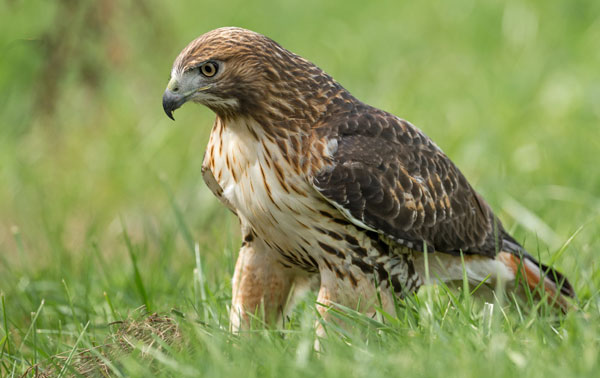
While the hawk watching on Cape Cod is often better in the spring than the fall, there’s still plenty of activity to check out. Spots on the Outer Cape are often the best bet, especially in the Spring when the hawks travel up the Outer Cape to Provincetown, and upon finding that their overland route has ended, tend to hang around the tip of the Outer Cape before flying back down across land. Mass Audubon has an extensive list of the best hawk watching locations in Massachusetts.
4. Snowy Owls: Winter Visitor to Cape Cod
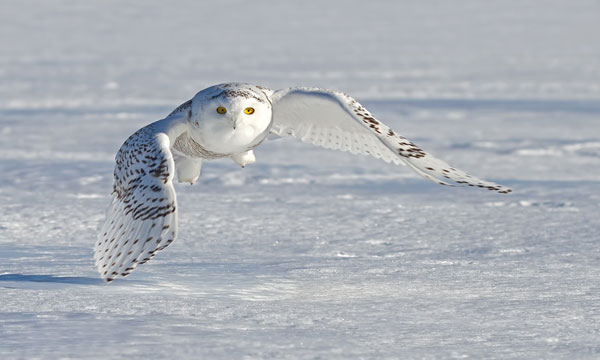
In a reversal of the pattern many of the other migratory species visiting Cape Cod embody, Snowy Owls sometimes spend their winters in the more southern climate of the Cape. The owls leave their Arctic grounds in response to various pressures, from a shortage of food or overabundance of owls.
Mass Audubon reports that contrary to popular belief for many years, the owls do not just appear when there is a shortage of their main food supply, lemmings, but also in cases where the previous year a boom in the lemming population allowed for a very successful nesting year for the snowy owls, thus creating a ‘superabundance’ of owls now looking for food in the Arctic.
Keep an eye out along salt marshes, in agricultural fields, and along roadways. The snowy owls are white with black markings, and ghostly quiet in flight.
5. Bluebirds: Migratory Birds of Cape Cod and Year Round Resident of Cape Cod

Increasingly common in Massachusetts in the winter, the Eastern Bluebird with its pop of color is a popular and welcome sight to many. While the birds were once rare, their population has rebounded. Many bird lovers have aided in this effort by building special birdhouses for bluebirds. The Cape Cod Bird Club has installed Bluebird boxes at several locations on the Cape, including Crowes Pasture, Thompson’s Field, Robert F. Smith Cold Brook Preserve, and Teixeira Field.
6. Mourning Doves: Migratory Birds of Cape Cod and Year-Round Resident of Cape Cod

With their distinct coo-ing, the Mourning Dove’s call can sometimes be mistaken for that of an owl. The bird has soft grey and brown plumage and are larger than most other birds you’d see at your backyard feeder. Fall is a great time to see flocks of the doves, often perched on telephone wires. While many of the doves fly south in the winters, more and more stick around, aided by backyard bird feeders.
7. European Starlings: Year-Round Resident of Cape Cod
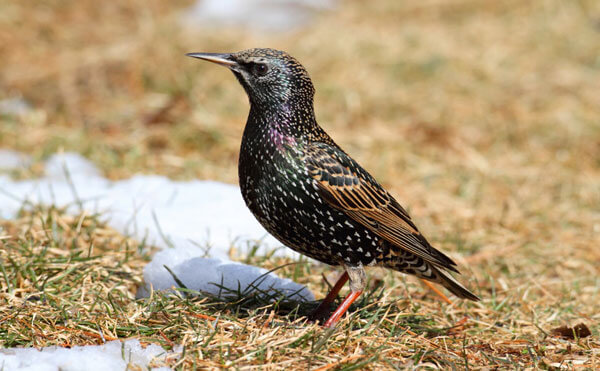
This species was introduced to North America in the 1800s by Eugene Scheiffelin. Scheiffelin’s goal was to introduce all the species of birds that were mentioned in the works of William Shakespeare. The starlings are not a quiet species, with their call often described as a cacophony. Like many introduced species the European Starling has usurped many native species and is one of the most common species in Massachusetts.
The birds often steal the nesting cavities of other species, leading many bird enthusiasts to make birdhouses with a particular diameter opening, too small for the starlings to enter. While some young starlings will fly south, many of the birds flock together for the winters, remaining in Massachusetts.
8. Northern Cardinals: Year-Round Resident of Cape Cod

A welcome pop of color in the winter months, the Northern Cardinal remains in Massachusetts year-round. A favorite at bird feeders, the flashier male cardinals can be identified by their red plumage, or located by their distinctive high, repetitive, and musical call. They use their beaks to crack tough seeds and eat fruits, nuts, and seeds to make it through the winter months, enjoying the addition of insects to their diet in the warmer months.
9. Black-capped Chickadees: Year-Round Resident of Cape Cod

With their ‘Chica-dee-dee-de’ call, this small bird has a distinct black cap, and can often be found hopping and fluttering around the branches of trees. The hardy birds flock with other species during the winter, including nuthatches and downy woodpeckers. The species, prevalent across the Commonwealth, was dubbed the Massachusetts State Bird in 1941. This social species can be found on the Cape year-round!
10. Ospreys: Migratory Birds of Cape Cod
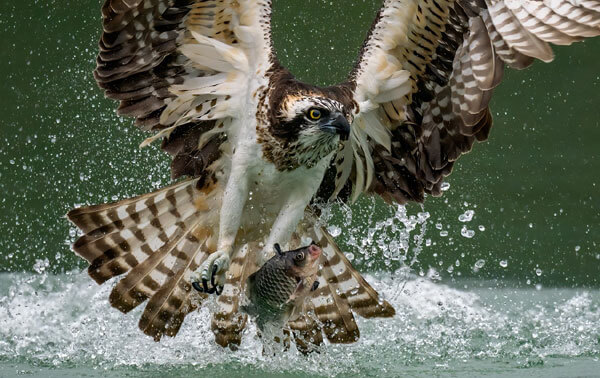
Another migratory bird of Cape Cod, the ospreys leave the Cape each September, spending their winters catching fish in Central and South America. They return to their impressive stick nests in March, heralding a shift to Spring on Cape Cod. The fierce bird of prey was nearly gone from Cape Cod, with their numbers down to just a handful of nesting pairs in the 1970’s. The decline was attributed to the use of DDT, a pesticide banned in 1972.
Thanks to conservation efforts, the species has rebounded. Nesting platforms have been constructed across the region. They are also aimed at providing an alternative to the birds who have a habit of nesting on utility poles near to power lines. Those looking to get involved with Osprey monitoring on Cape Cod should be sure to get involved with the Center for Conservation Biology’s Cape Cod Osprey Watch.



